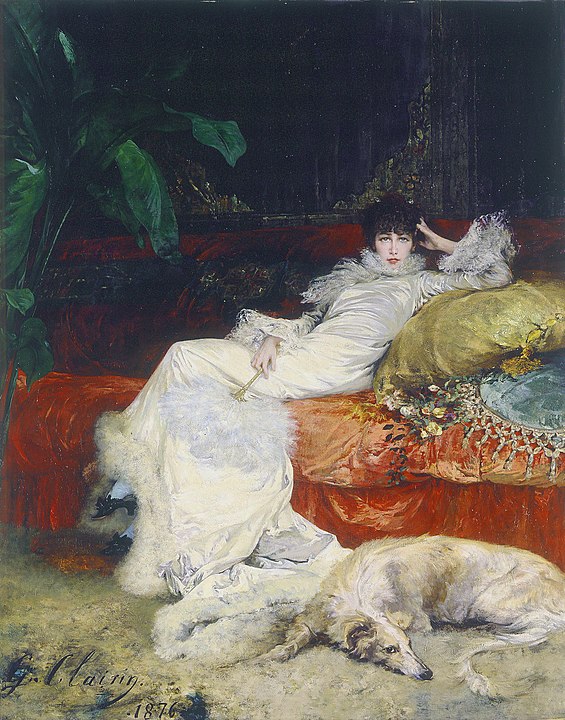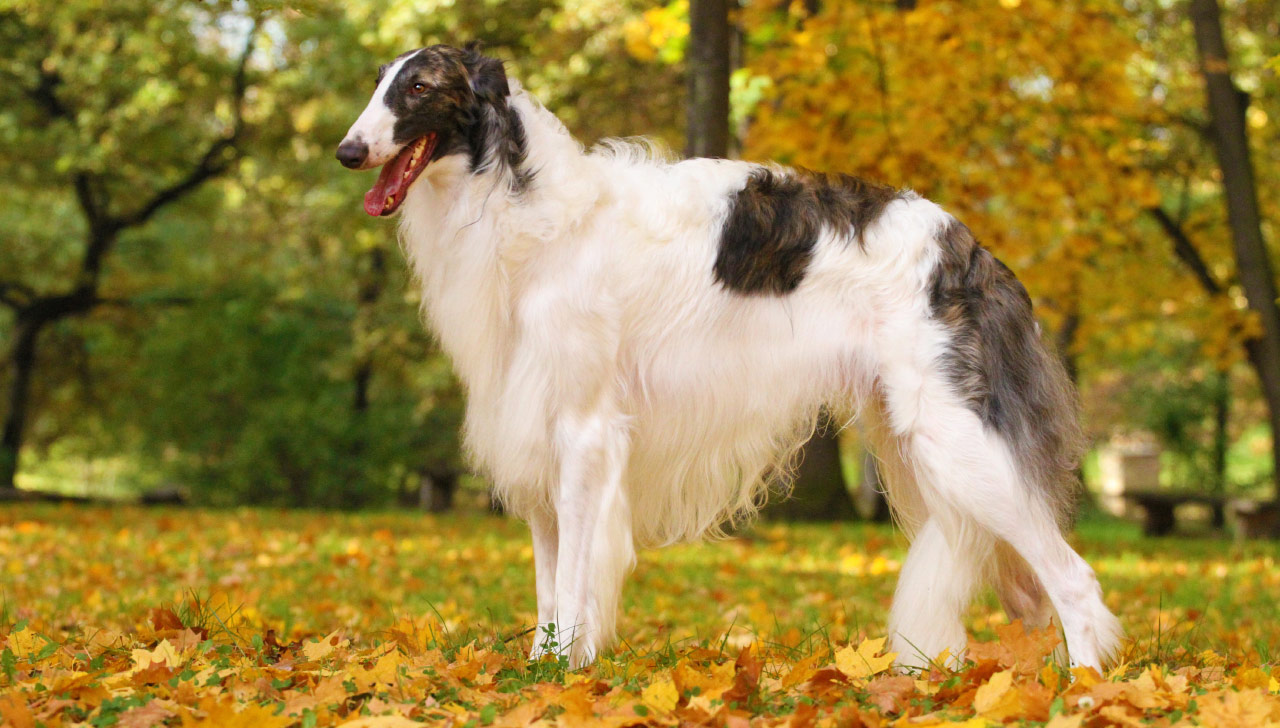Other names: Barzoï, Russian wolfhound, Russian hunting sighthound or Russkaya psovaya borzaya.
The borzoi also called the Russian wolfhound or Walking Cloud is a breed of domestic dog. Descended from dogs brought to Russia from central Asian countries, it is similar in shape to a greyhound and is also a member of the sighthound family.
The system by which Russians over the ages named their sighthounds was a series of descriptive terms, not actual names. Borzói is the masculine singular form of an archaic Russian adjective that means “fast”. Borzáya sobáka (“fast dog”) is the basic term used by Russians, though sobáka is usually dropped. The name psovaya derived from the word psovina, which means “wavy, silky coat”, just as hortaya (as in hortaya borzaya) means shorthaired. In modern Russian, the breed commonly called the borzoi is officially known as russkaya psovaya borzaya. Other Russian sighthound breeds are stepnaya borzaya, called stepnoi; and krimskaya borzaya, called krimskoi.
The most commonly used plural form is the regular formation borzois, which is the only plural cited in most dictionaries. However, the Borzoi Club of America and the Borzoi Club UK both prefer borzoi as the form for both singular and plural forms.
Appearance
Borzois are large Russian sighthounds that resemble some central Asian breeds such as the Afghan hound, Saluki, and the Kyrgyz Taigan. Borzois can generally be described as “long-haired greyhounds”. Borzois come in virtually any colour. The borzoi coat is silky and flat, often wavy or slightly curly. The long top-coat is quite flat, with varying degrees of waviness or curling. The soft undercoat thickens during winter or in cold climates but is shed in hot weather to prevent overheating. In its texture and distribution over the body, the borzoi coat is unique. There should be a frill on its neck, as well as feathering on its hindquarters and tail.
Borzoi males frequently weigh more than 100 pounds (45 kg). Males stand at least 30 inches (76 cm) at the shoulder, while the height of females is around 26 inches (66 cm). Despite their size, the overall impression is of streamlining and grace, with a curvy shapeliness and compact strength.
History

The Borzoi originated in 17th Century Russia by crossing Arabian greyhounds with a thick-coated breed.
The more modern Psovaya Borzaya was founded on Stepnaya, Hortaya and the Ukrainian-Polish version of the old Hort. There were also imports of Western sighthound breeds to add to the height and weight. It was crossed as well with the Russian Laika specifically and singularly to add resistance against Northern cold and a longer and thicker coat than the Southern sighthounds were equipped with.
All of these foundation types—Tazi, Hortaya, Stepnaya, Krimskaya, and Hort—already possessed the instincts and agility necessary for hunting and bringing down wolves.
The Psovoi was popular with the Tsars before the 1917 revolution. For centuries, Psovoi could not be purchased but only given as gifts from the Tsar. Grand Duke Nicholas Nicolaievich of Russia bred countless Psovoi at Perchino, his private estate.
The Russian concept of hunting trials was instituted during the era of the Tsars. As well as providing exciting sport, the tests were used for selecting borzoi breeding stock; only the quickest and most intelligent hunting dogs went on to produce progeny. For the aristocracy these trials were a well-organized ceremony, sometimes going on for days, with the borzois accompanied by mounted hunters and Foxhounds on the Russian steppe. Hares and other small game were by far the most numerous kills, but the hunters especially loved to test their dogs on the wolf. If a wolf was sighted, the hunter would release a team of two or three borzois. The dogs would pursue the wolf, attack its neck from both sides, and hold it until the hunter arrived. The classic kill was by the human hunter with a knife. Wolf trials are still a regular part of the hunting diploma for all Russian sight dog breeds of the relevant type, either singly or in pairs or trios, in their native country.
After the 1917 Revolution, wolf hunting with sighthounds has soon gone out of fashion as an “aristocratic” and a means- and -time-taking way of hunting. A necessity in a wolf-catching sighthound didn’t exist, in addition to the old proved technique of battle with the use of baits, flags and other appeared new, way more effective—from aeroplanes, from propeller sleighs, with electronic lure whistles. For decades the generations of few remaining sighthounds were regarded as hunting-suited when showing enough attacking initiative for fox hunting. The rumour about the persecution of sighthounds in post-revolutionary Russia is a legend of modern times, possibly based on similar incidents in Maoist China.
In the late 1940s, a Soviet soldier named Constantin Esmont made detailed records of the various types of borzoi he found in Cossack villages. Esmont’s illustrations were recently published and can be viewed by clicking on the link below.
Esmont was concerned that the distinct types of borzaya were in danger of degenerating without a controlled system of breeding. He convinced the Soviet government that borzois were a valuable asset to the hunters who supported the fur industry and henceforth, their breeding was officially regulated. To this day short-haired Hortaya Borzaya is highly valued hunting dogs on the steppes, while the long-haired Psovaya Borzaya, is going through a hard period of restoration of its working qualities after decades of shadow, mainly show existence.
Exports of borzois to other countries were extremely rare during the Soviet era. However, enough had been taken to England, Scandinavia, Western Europe, and America in the late 19th century for the breed to establish itself outside its native country.
